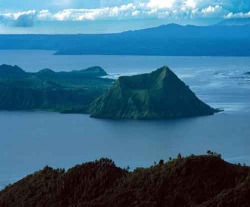TAAL VOLCANO ( The smallest and the biggest volcano in the world)

Taal Volcano is located about 60 km SSE of Metro Manila, the capital of the Philippines. It is a complex volcanic system composed of a small volcanic island (Volcano Island), which has been the site of almost all historic activity, located within a 20x30 km lake-filled complex caldera(?) (Taal Lake, in older texts also called Lake Bonbon), one of the great volcano-tectonic depressions of the world.Taal can be considered the smallest and the biggest at the same time for volcanoes seen around the globe.
Thirty three eruptions have been recorded since 1572 at Taal, mostly on Volcano Island. The impacts of these eruptions were largely confined to the intracaldera area. Occasional violent activity, however, such as the 1754 plinian eruption, affected the entire region, including what is now the Metro Manila area with fallout. Some activity, such as the 1749 eruption, were accompanied by crustal disturbance and strong earthquakes, which generated ground fissures and pronounced subsidence that extended across Taal lake. The caldera has a long, but little known history of catastrophic explosive volcanism affecting much larger areas, including the Metro Manila area. The eruptions, one to two orders of magnitude larger and more devastating than those of Mount Pinatubo, have deposited massive ignimbrites, including the deposits of turbulent pyroclastic flows, and widespread tephra fall units in recent geologic time. Accompanying this volcanism has been extensive volcaniclastic sedimentation, dominated by deposition of hyperconcentrated streamflows and lahars in low-lying subaerial and shallow marine environments.
The Philippine Institute of Volcanology and Seismology's (PHIVOLCS) choice of a Decade Volcano from among the 200 volcanoes in the Philippines rests on Taal's obvious and dangerous attributes:
